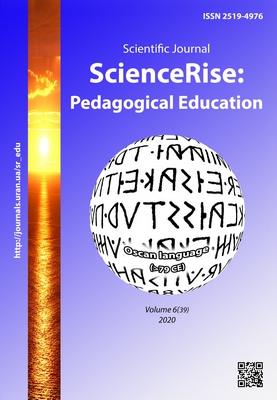A method of phase formation of vocal sound at activities of a training choral collective
DOI:
https://doi.org/10.15587/2519-4984.2020.217050Keywords:
vocal sound, vocal skills, registers, resonators, sound position, choir, unisonAbstract
The article is devoted to coverage of the stages of forming the vocal sound in a classroom training choir, united in the phase sequence. The feature of the first phase of the vocal sound formation is the creation of the psychological setting, which leads to the very essence of singers’ activity. The second phase is characterized by a change in sound timbre similitude. Enormous pressure is required from the central nervous system to concentrate the inner mental work and make coordination. The sign of the third phase is the appearance of higher positional sound. In the fourth phase, the singing actions are more dynamically stable and coordinated. The fourth phase is characterized by broad compact timbre sound, but something too heavy by the power. A characteristic feature of the fifth phase is the automation of vocal skills, the sound gets flexibility and plasticity. The mechanism of stabilization in the formation of vocal skills that ensure the accuracy, efficiency and stability of the movements of the articulatory apparatus is analyzed. We have substantiated the method of imitation as a psychological process, transformed in the active thinking work and implemented in practice.The basic points of the head of a choir are analyzed, including: work on rounding lighting the sound, singing properly on the organized breathing support, forming a unified manner of sounding voices. It is noted, that the complex interaction of breath, soft palate and larynx ensures the correct formation of the vocal sound. It is determined, that the sound acquires a full quality characteristic only due to the smoothing of the registers. The main criteria of the set, academic voice are characterized, namely: the presence of two singing forms and the work of two resonators, which are equally involved in the formation of both low and high sounds. The mechanism of voice synchronization in choral parts is characterized
References
- Ovcharenko, N. (2014). Profesiina pidhotovka maibutnikh vchyteliv muzychnoho mystetstva do vokalno-pedahohichnoi diialnosti: teoriia ta metodolohiia. Kryvyi Rih: Vyd. R.A. Kozlov, 400.
- Emelianov, V. V. (2000). Razvitie golosa. Koordinatsiia i trening. Seriia Mir meditsiny. Saint Petersburg: Lan, 192.
- Osenneva, M. S., Samarin, V. A. (2003). Khorovoi klass i prakticheskaia rabota s khorom. Moscow: Akademiia, 192.
- Babichenko. N. O. (2017). Forming of vocal-choral skills of teenagers in extra-curricular activity. Topical Issues of Science and Education. Poland, 5, 103–108.
- Kosinska, N. L. (2017). Formuvannia stsenichnoho obrazu maibutnikh uchyteliv muzychnoho mystetstva u protsesi vokalno-vykonavskoi pidhotovky. Naukovi zapysky Kirovohradskoho derzhavnoho pedahohichnoho universytetu imeni Volodymyra Vynnychenka. Seriia: Pedahohichni nauky, 155, 134–138.
- Wang, L. (2010). Formation of Vocal and Acting Skills of a Future Music Teacher. Kyiv, 23.
- Kuznetsov, Yu. M. (2007). Kvaziharmoniinist spivochoho holosu. Holos. Moscow, 7–12.
- Nikolskaia-Beregovskaia, K. F. (1998). Russkaia vokalno-khorovaia shkola IX-XX vekov. Moscow: IAzyki russkoi kultury, 192.
- Kyfenko, А. (2018). Experimental reviem of the effectiveness of the music aural activity formation of prospective music teachers in the training choir. Pedagogical sciences: theory, history, innovative technologies, 9 (83), 251–261. doi: http://doi.org/10.24139/2312-5993/2018.09/251-261
- Tremzina, O. S. (2014). Dirizherskii zhest i muzykalnaia intonatsiia. Covremennye problemy nauki i obrazovaniia, 1. Available at: https://www.science-education.ru/ru/article/view?id=11847
- Varlamov, D. I. (2013). Artikuliatsiia v dirizhirovanii. Orkestr, 1-2, 14–16.
- Dmitriev, L. B. (1968). Osnovy vokalnoi pedagogiki. Moscow: Muzyka, 674.
- Tsiatsiun, S. (2018). Step-by-step methodology of the musical and listening culture of adolescents by means of multimedia. Scientific Bulletin of Mukachevo State University Series “Pedagogy and Psychology”, 1 (7), 154–156. doi: http://doi.org/10.31339/2413-3329-2018-1(7)-154-156
- Galleev, B. (2006). Iskusstvo v pole tiagoteniia. Saratov: SGK im. L. V. Sobinova, 48–49.
Downloads
Published
How to Cite
Issue
Section
License
Copyright (c) 2020 Anna Kyfenko, Tetyana Romanova

This work is licensed under a Creative Commons Attribution 4.0 International License.
Our journal abides by the Creative Commons CC BY copyright rights and permissions for open access journals.
Authors, who are published in this journal, agree to the following conditions:
1. The authors reserve the right to authorship of the work and pass the first publication right of this work to the journal under the terms of a Creative Commons CC BY, which allows others to freely distribute the published research with the obligatory reference to the authors of the original work and the first publication of the work in this journal.
2. The authors have the right to conclude separate supplement agreements that relate to non-exclusive work distribution in the form in which it has been published by the journal (for example, to upload the work to the online storage of the journal or publish it as part of a monograph), provided that the reference to the first publication of the work in this journal is included.








